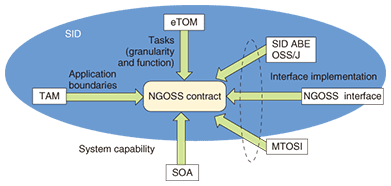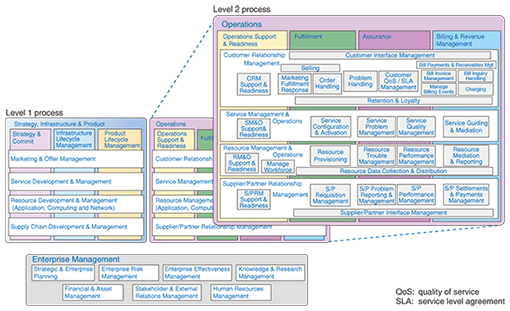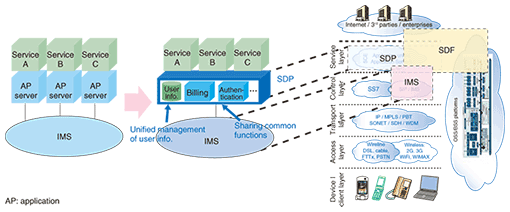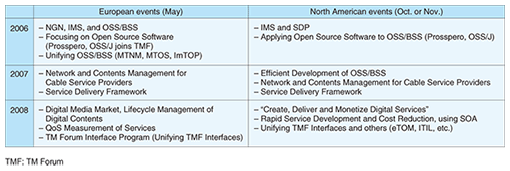 |
|||||
|
|
|||||
|
Global Standardization Activities Vol. 7, No. 10, pp. 31–35, Oct. 2009. https://doi.org/10.53829/ntr200910gls Standardization Trends in the TeleManagement Forum (TM Forum)AbstractThis article briefly describes the TeleManagement Forum (TM Forum), a worldwide organization concerned with telecommunication operations, and outlines recent trends. The TM Forum is studying frameworks for business processes and for data and information with the objective of providing general solutions for telecommunications operations, and it is involved in the standardization process.
1. Overview of TM ForumThe TeleManagement Forum (TM Forum) [1] is a worldwide organization concerned with telecommunication operations. Its main purposes include the setting and promotion of international standards and industrial standards to achieve interoperability in communication network management and the promotion of products based on those standards. The organization was established as the OSI/Network Management Forum, a non-profit organization, in June 1988 by eight founding members: Amdahl, AT&T, British Telecom, Hewlett-Packard Co., Northern Telecom, Telecom Canada, STC, and Unisys (OSI: Open Systems Interconnection; STC: formerly Standard Telephones and Cables). As of May 2009, there were over 700 corporate participants from more than 75 countries. The membership includes all of the world’s top ten telecommunications corporations in terms of sales, which includes NTT. The diverse membership includes cable operators and content providers as well as broadcasters, reflecting the efforts in recent years directed at overall digital content business promotion and value chain construction in addition to telecommunications operation technology. The TM Forum has two specific activities. One is producing technical specifications and white papers, business agreement documents, interface specifications, etc., which is done by individual technical study teams (called the Collaboration Program in the TM Forum). The other is holding the biannual Management World technical conferences and coordinating various exhibitions held by telecommunications enterprises and solution providers. Below, we describe the TM Forum operations technologies being studied by the Collaboration Program and some of the trends in the Management World. 2. NGOSSIn the TM Forum, a next-generation solutions framework called the New Generation Operations Systems and Software (NGOSS) is being studied to enable general reuse of carrier and vendor expertise on processing, information models, systems integration methods, and application components in constructing operations and business support systems (OSS/BSS). More specifically, NGOSS comprises a number of technological elements, as shown in Fig. 1.
The business processes framework (eTOM: Enhanced Telecom Operation Map) analyzes business tasks and specifies their granularity; the applications framework (TAM: Telecom Application Map) specifies a framework for general-use applications; and the information framework (SID: Shared Information and Data Model) specifies global information and data that is common to NGOSS overall. Specifications concerning interfaces and implementations include SID ABE (Aggregate Business Entities; a coarse business entity bundles multiple eTOM business processes), OSS/J (OSS through Java Initiative), and MTOSI (Multi-Technology Operations System Interface, which specifies the interface between network management systems (NMSs). These NGOSS component technologies are being studied by their respective Technical Study Teams. For the specification of system capabilities and performance, a service-oriented architecture (SOA) approach is used. 2.1 eTOMeTOM is a standard framework for performing general management of the different business processes that are defined for each original service provider and classifying them in a matrix. It can be used as a check for comprehensiveness in the design of a business strategy to avoid the omission of business processes. Moreover, rapid construction of internal operation systems can be expected when market products based on these standard frameworks are introduced. Originally, there was mapping of various processes to customer management, service development and management, and network management, but eTOM extends the range to also take into account business strategy & product management and enterprise management. The lower left of Fig. 2 presents the level-1 process classification. Finer level-2 operations definitions are given in the upper right. Currently, even more detailed level-3 definitions are in progress, and part of the Enterprise Management area is proceeding to level 4. Recently, studies on integrating eTOM with ITIL (Information Technology Infrastructure Library), which is a standard for information technology service management and operation technique specifications, have been progressing.
2.2 SIDThe SID model is a standard information and data framework specified by NGOSS. Definitions of the information and data used in each task are being organized and systematized and mapped to the eTOM task process framework. SID level 0 is divided into eight domains: Market and Sales, Product, Customer, Service, Resources, Suppliers and Partners, Enterprise, and Common Tasks. Each domain is a hierarchy of levels of detail in the form of business entities. The use of SID is expected to facilitate the construction of consistent data models based on international standards and cooperation among multiple systems, etc. 2.3 TAMTAM is a standard framework for organizing and mapping the application functions provided by telecommunications carriers. Its seven domains are Market and Sales, Product, Customer, Service, Resources, Suppliers and Partners, and Enterprise, which are integrated by an integration infrastructure. 2.4 OSS/BSS integrated interfaceThe TM Forum is specifying an OSS/BSS integrated interface (TIP: TM Forum Interface Program). It will attempt to integrate IPDR, an integrated charging method among Internet protocol (IP) services, the mTOP (MTNM (Multi-Technology Network Management) and MTOSI) specification for the NMS-EMS interface between the network and element management systems and the interface between the NMS and the OSS/J common telecom OSS application programming interface. This is intended to create a common base for technician skills and to unify roadmaps. 2.5 SDP/SDFThe service delivery platform (SDP) and service delivery framework (SDF) are attracting attention as technologies for next-generation networks such as the Next Generation Network (NGN) and facilitating service development and distribution on the IP Multimedia Subsystem (IMS). The SDP facilitates the implementation and provision of various types of services by sharing common functions independently of the service and by providing unified management of user information when various types of services are implemented on a next-generation network architecture such as IMS. The SDF, on the other hand, is positioned as a service layer in the same way as SDP; however, in cooperation with OSS/BSS, it is a framework for a wider range of studies, taking into account functional division and so on. The positioning of SDF and SDP is shown in Fig. 3.
The TM Forum is proceeding with SDF studies, which also take into account OSS/BSS cooperation, with the main discussion and studies being done by members such as Telcordia, AT&T, and Alcatel-Lucent. In addition, SDF-equivalent functions of other standards organizations besides the TM Forum and technologies of other organizations that should be used in the TM Forum’s SDF specifications are also being compared and analyzed. 3. Recent trendsTopics at recent TM Forum Management World Conferences are listed in Table 1. Since about 2006, there have been many topics related to the management of IMS and NGN. Another major issue has been the application of open source technology to network management. Since 2007, the content lifecycle and value chain management, service delivery frameworks, and other such topics have been attracting attention. At the November 2008 conference, the application of information and communications technology (ICT) in the field of military defense and the impact of worldwide economic recession on the field of telecommunications were raised as issues and a broad range of fields were discussed. The TM Forum is also active in cooperation and combination or integration with other industrial standards organizations etc., and unions or technical integrations with four organizations—OSS/J, GBA (Global Billing Association), IPDR.org (Internet Protocol Detail Record Organization), and IPsphere Forum—have been announced since 2006 alone. Thus, the field of TM Forum studies is continuing to expand.
4. ConclusionThe TM Forum is a leader in industrial standards for network management whose results are often adopted in ITU-T (International Telecommunication Union, Telecommunication Standardization Sector) international standards. We intend to continue watching the issues taken up by the TM Forum and monitor the subsequent technical studies and industrial trends. Reference
|
|||||












